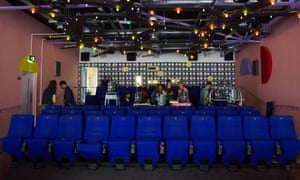Threatened – with vibrancy
City News is a regular fictional account of what is in the pipeline for the citizenry of this great city, though, to be fair, some of it is inadvertently – one presumes – revealing.
The Grand Design for wrecking one of the country's least known but important Georgian-Victorian cities was mapped out by the ineffable T.Dan Smith half a century ago. There is a scene in a film made at that time of planners in Smith's seat-of-Empire solemnly placing small rectangular blocks of polished wood on a model of the 'new' Newcastle as envisaged*. A series of fiercely yet talent free cuboids would spread out over a demolished city centre through whose canyons cars would freely circulate ... Freely because, in around 1970 or so, there would never be more than a handful. Such is the optimism of planners.
Only part of Smith's 'vision' was created. Bits remain, testament to a fact of the impersistence of Modernist dreams, that concrete does not weather, it only rots. The damage was heroic if the reality is not. Today log jam cars queue through the mid afternoon to go at walking speed over the Tyne Bridge and yet still more to come. For this, much that had grace, vigour and grandeur went down to dust.
So has Smith and most of his deeply unedifying acolytes. But the 'legacy' seemingly persists, warmed up from time to time. Those wood blocks are safe in some cupboard one feels.
City News is gushing this month. It even held a launch of its Trust for the city parks in Leazes Park. Last century the City Council wanted to hive off Leazes Park to Sir John Hall's 'Newcastle United Sporting Club' creating a private playground from a public space on Common Land, the Town Moor. Unsurprisingly, given the players on this pitch, this kind of beneficent approach to the public interest survived that debacle and the shameless
City News announces that somewhere it has just decided to call East Pilgrim Street is preparing to go 'vibrant'. Anyone with a memory must tremble at the prospect.
It is common knowledge that the 'High Street' is struggling. Eldon Square and Northumberland Street hold the majority of the large established chains in the city. None are exactly thrilled by the idea another set of stores are planned to join in slicing, even very thinly, the available shopping pound. The news that 'East Pilgrim Street' –
vibrant East Pilgrim Street – is about to be developed as another additional shopping venue for the city, regional centre for shopping no less, might not be the Christmas present the writer of this gushing piece believes it to be. True there is not much competition for miles around, but then again, there is this invention the internet ... you see where this is going.
But all is not what it seems, as is usually, almost invariably in fact, the case with these
City News bombshells. The crucial kickstart here, 'key turning' I think the term is, will be a gigantic block of offices –
'Work is expected (nb) next year on the glass fronted (wow!) building which (sic) has been hailed (by whom?) as the catalyst for the rebirth of East Pilgrim Street' – with emendations Ed.
To be followed by more bars, 'leisure' and 'living' developments and a 'pavilion' towards Carliol Square if the wind is set fair and vibrancy doesn't flag.
Eagle eyed among you will be some who will recall the rather large new offices that have been built around the city this century that have never had a paying tenant. As for bars, well, there are no end to the number Newcastle can support it seems. As with all the
News one must watch this space.
*Commissioned from the Amber Films collective it was never used. Latterly, and perhaps not unconnected, Amber Films led the fight to preserve the historic Quayside from the wood block treatment. As is, the Quayside is perhaps the singular reason Newcastle is Newcastle still.



